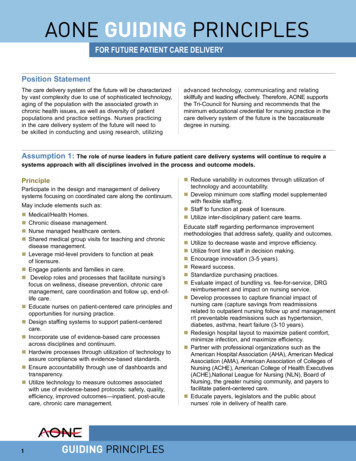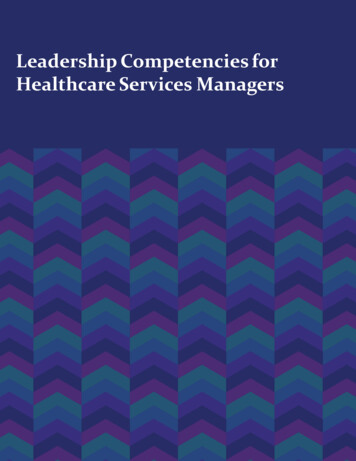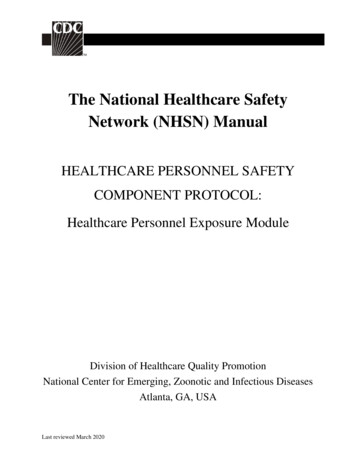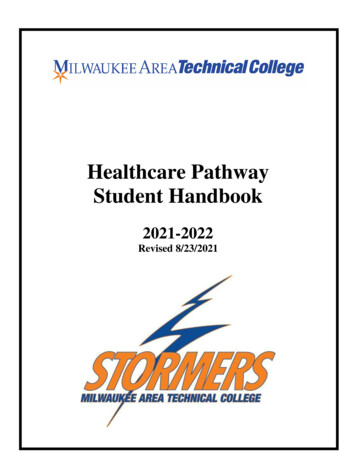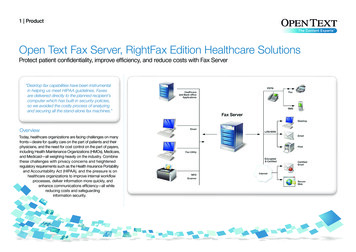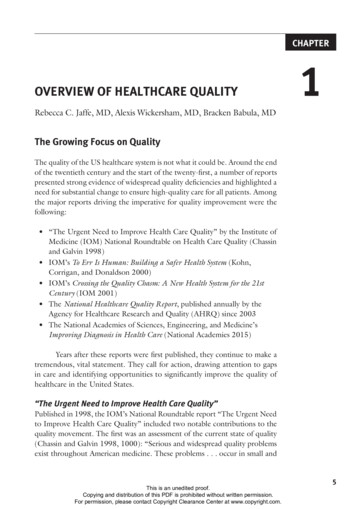
Transcription
CHAPTEROVERVIEW OF HEALTHCARE QUALITY1Rebecca C. Jaffe, MD, Alexis Wickersham, MD, Bracken Babula, MDThe Growing Focus on QualityThe quality of the US healthcare system is not what it could be. Around the endof the twentieth century and the start of the twenty-first, a number of reportspresented strong evidence of widespread quality deficiencies and highlighted aneed for substantial change to ensure high-quality care for all patients. Amongthe major reports driving the imperative for quality improvement were thefollowing: “The Urgent Need to Improve Health Care Quality” by the Institute ofMedicine (IOM) National Roundtable on Health Care Quality (Chassinand Galvin 1998) IOM’s To Err Is Human: Building a Safer Health System (Kohn,Corrigan, and Donaldson 2000) IOM’s Crossing the Quality Chasm: A New Health System for the 21stCentury (IOM 2001) The National Healthcare Quality Report, published annually by theAgency for Healthcare Research and Quality (AHRQ) since 2003 The National Academies of Sciences, Engineering, and Medicine’sImproving Diagnosis in Health Care (National Academies 2015)Years after these reports were first published, they continue to make atremendous, vital statement. They call for action, drawing attention to gapsin care and identifying opportunities to significantly improve the quality ofhealthcare in the United States.“The Urgent Need to Improve Health Care Quality”Published in 1998, the IOM’s National Roundtable report “The Urgent Needto Improve Health Care Quality” included two notable contributions to thequality movement. The first was an assessment of the current state of quality(Chassin and Galvin 1998, 1000): “Serious and widespread quality problemsexist throughout American medicine. These problems . . . occur in small andThis is an unedited proof.Copying and distribution of this PDF is prohibited without written permission.For permission, please contact Copyright Clearance Center at www.copyright.com.5
6T h e Healt h c a re Qu a l i ty B o o klarge communities alike, in all parts of the country, and with approximatelyequal frequency in managed care and fee-for-service systems of care. Very largenumbers of Americans are harmed.” The second contribution was the categorization of quality defects into three broad categories: underuse, overuse, andmisuse. This classification scheme has become a common nosology for qualitydefects and can be summarized as follows: Underuse occurs when scientifically sound practices are not used asoften as they should be. For example, only 72 percent of womenbetween the ages of 50 and 74 reported having a mammogram withinthe past two years (White et al. 2015). In other words, nearly one infour women does not receive treatment consistent with evidence-basedguidelines. Overuse occurs when treatments and practices are used to a greaterextent than evidence deems appropriate. Examples of overuseinclude imaging studies for diagnosis of acute low-back pain and theprescription of antibiotics for acute bronchitis. Misuse occurs when clinical care processes are not executed properly—for example, when the wrong drug is prescribed or the correct drug isprescribed but incorrectly administered.To Err Is Human: Building a Safer Health SystemAlthough the healthcare community had been cognizant of its quality challengesfor years, the 2000 publication of the IOM’s To Err Is Human exposed theseverity and prevalence of these problems in a way that captured the attentionof a large variety of key stakeholders for the first time. The executive summaryof To Err Is Human begins with the following headlines (Kohn, Corrigan, andDonaldson 2000, 1–2):The knowledgeable health reporter for the Boston Globe, Betsy Lehman, died froman overdose during chemotherapy. . . .Ben Kolb was eight years old when he died during “minor” surgery due toa drug mix-up. . . .[A]t least 44,000 Americans die each year as a result of medical errors. . . .[T]he number may be as high as 98,000. . . .Total national costs . . . of preventable adverse events . . . are estimated to bebetween 17 billion and 29 billion, of which health care costs represent over one-half.Although many people had spoken about improving healthcare in thepast, this report focused on patient harm and medical errors in an unprecedented way, presenting them as perhaps the most urgent forms of qualitydefects. To Err Is Human framed the problem in a manner that was accessibleThis is an unedited proof.Copying and distribution of this PDF is prohibited without written permission.For permission, please contact Copyright Clearance Center at www.copyright.com.
C h ap ter 1: Over v iew of H ealthc are Q ualityto the public, and it clearly demonstrated that the status quo was unacceptable.For the first time, patient safety became a unifying cause for policy makers,regulators, providers, and consumers.Crossing the Quality Chasm: A New Health System for the 21stCenturyIn March 2001, soon after the release of To Err Is Human, the IOM releasedCrossing the Quality Chasm, a more comprehensive report that offered a newframework for a redesigned US healthcare system. Crossing the Quality Chasmprovides a blueprint for the future that classifies and unifies the componentsof quality through six aims for improvement. These aims, also viewed as sixdimensions of quality, provide healthcare professionals and policy makers withsimple rules for redesigning healthcare. They can be known by the acronymSTEEEP ( Berwick 2002):1. Safe: Harm should not come to patients as a result of their interactionswith the medical system.2. Timely: Patients should experience no waits or delays when receivingcare and service.3. Effective: The science and evidence behind healthcare should be appliedand serve as standards in the delivery of care.4. Efficient: Care and service should be cost-effective, and waste should beremoved from the system.5. Equitable: Unequal treatment should be a fact of the past; disparities incare should be eradicated.6. Patient-centered: The system of care should revolve around the patient,respect patient preferences, and put the patient in control.Improving the quality of healthcare in the STEEEP focus areas requireschange to occur at four different levels, as shown in exhibit 1.1. Level A isthe patient’s experience. Level B is the microsystem where care is delivered bysmall provider teams. Level C is the organizational level—the macrosystem oraggregation of microsystems and supporting functions. Level D is the externalenvironment, which includes payment mechanisms, policy, and regulatoryfactors. The environment affects how organizations operate, operations affectthe microsystems housed within organizations, and microsystems affect thepatient. “True north” lies at level A, in the experience of patients, their lovedones, and the communities in which they live (Berwick 2002).National Healthcare Quality ReportMandated by the US Congress to focus on “national trends in the quality ofhealthcare provided to the American people” (42 U.S.C. 299b-2(b)(2)), theThis is an unedited proof.Copying and distribution of this PDF is prohibited without written permission.For permission, please contact Copyright Clearance Center at www.copyright.com.7
8T h e Healt h c a re Qu a l i ty B o o kEXHIBIT 1.1The FourLevels of theHealthcareSystemEnvironmentLevel DOrganizationLevel CMicrosystemLevel BPatientLevel AAHRQ’s annual National Healthcare Quality Report highlights progress andidentifies opportunities for improvement. Recognizing that the alleviation ofhealthcare disparities is integral to achieving quality goals, Congress furthermandated that a second report, the National Healthcare Disparities Report,focus on “prevailing disparities in health care delivery as it relates to racialfactors and socioeconomic factors in priority populations” (42 U.S.C. 299a1(a)(6)). AHRQ’s priority populations include women, children, people withdisabilities, low-income individuals, and the elderly. The combined reportsare fundamental to ensuring that improvement efforts simultaneously advancequality in general and work toward eliminating inequitable gaps in care.These reports use national quality measures to track the state of healthcare and address three questions:1. What is the status of healthcare quality and disparities in the UnitedStates?2. How have healthcare quality and disparities changed over time?3. Where is the need to improve healthcare quality and reduce disparitiesgreatest?In its 2016 National Healthcare Quality and Disparities Report, theAHRQ (2016) notes several improvements, including improved access tohealthcare, better care coordination, and improvement in patient-centeredcare. Despite these improvements, many challenges and disparities remain withregard to insurance status, income, ethnicity, and race.This is an unedited proof.Copying and distribution of this PDF is prohibited without written permission.For permission, please contact Copyright Clearance Center at www.copyright.com.
C h ap ter 1: Over v iew of H ealthc are Q ualityImproving Diagnosis in Health CareThe National Academies of Sciences, Engineering, and Medicine’s (2015)report on Improving Diagnosis in Health Care claims that most people willexperience at least one diagnostic error—defined as either a missed or delayeddiagnosis—in their lifetime. Diagnostic errors are thought to account for upto 17 percent of hospital-related adverse events. Likewise, up to 5 percent ofpatients in outpatient settings may experience a diagnostic error.Previous reports had steered clear of discussing diagnostic error, perhapsfearing that the topic assigns blame to clinicians on a personal level. This report,however, proposes an organizational structure for the diagnostic process, allowing for analysis of where healthcare may be failing and what might be doneabout it. The National Academies recommend that healthcare organizationsinvolve patients and families in the diagnosis process, develop health information technologies to support the diagnostic process, establish a culture thatembraces change implementation, and promote research opportunities ondiagnostic errors (National Academies 2015).How Far Has Healthcare Come?More than fifteen years after the prevalence of medical errors was brought tolight in To Err Is Human, the healthcare in the United States has seen a callto arms for the improvement of quality and safety. But has anything reallychanged? A 2016 analysis published by the British Medical Journal suggestsnot. The article, titled “Medical Error—The Third Leading Cause of Deathin the US,” delivers a shocking realization of the scope of medical error inhealthcare today. Using death certificate records along with national hospitaladmission data, Makary and Daniel (2016) conclude that, if medical errors aretracked as diseases are, they account for more than 250,000 deaths annually inthe United States—outranked only by heart disease and cancer.To Err Is Human and Crossing the Quality Chasm were catalysts forchange in healthcare, and they led to increased recognition and reporting ofmedical error and improved accountability measures set by governing bodies.Nonetheless, more work needs to be done to shrink the quality gap in UShealthcare. The remainder of this chapter will focus on frameworks for qualityimprovement, providing a deeper dive into the STEEEP goals and examiningstakeholder needs, measurement concepts, and useful models and tools.Frameworks and StakeholdersThe six STEEEP aims (Berwick 2002), as presented in Crossing the QualityChasm, provide a valuable framework that can be used to describe quality at anyof the four levels of the healthcare system. The various stakeholders involvedThis is an unedited proof.Copying and distribution of this PDF is prohibited without written permission.For permission, please contact Copyright Clearance Center at www.copyright.com.9
10T h e Healt h c a re Qu a l i ty B o o kin healthcare—including clinicians, patients, health insurers, administrators,and the general public—attach different levels of importance to particular aimsand define quality of care differently as a result (Bodenheimer and Grumbach2009; Harteloh 2004).The STEEEP FrameworkSafetySafety refers to the technical performance of care, but it also includes otheraspects of the STEEEP framework. Technical performance can be assessed basedon the success with which current scientific medical knowledge and technologyare applied in a given situation. Assessments of technical performance typicallyfocus on the accuracy of diagnoses, the appropriateness of therapies, the skillwith which procedures and other medical interventions are performed, andthe absence of accidental injuries (Donabedian 1988a, 1980).TimelinessTimeliness refers to the speed with which patients are able to receive care orservices. It inherently relates to access to care, or the “degree to which individuals and groups are able to obtain needed services” (IOM 1993). Pooraccess leads to delays in diagnosis and treatment. Timeliness can also manifestas the patient experience of wait times—either the wait for an appointment orthe wait in the medical facility. Timeliness is often a balance between qualityof care and speed of care.EffectivenessEffectiveness refers to standards of care and how well they are implemented.Perceptions of the effectiveness of healthcare have evolved over the years toincreasingly emphasize value. The cost-effectiveness of a given healthcareintervention is determined by comparing the potential for benefit, typicallymeasured in terms of improvement in individual health status, with the intervention’s cost (Drummond et al. 2005; Gold et al. 1996). As the amount spenton healthcare services grow, each unit of expenditure ultimately yields eversmaller benefits until no further benefit accrues from additional expenditureson care (Donabedian, Wheeler, and Wyszewianski 1982).EfficiencyEfficiency refers to how well resources are used to achieve a given result.Efficiency improves whenever fewer resources are used to produce an output.Because inefficient care uses more resources than necessary, it is wasteful care,and care that involves waste is deficient—and therefore of lower quality—nomatter how good it may be in other respects. “Wasteful care is either directlyThis is an unedited proof.Copying and distribution of this PDF is prohibited without written permission.For permission, please contact Copyright Clearance Center at www.copyright.com.
C h ap ter 1: Over v iew of H ealthc are Q ualityharmful to health or is harmful by displacing more useful care” (Donabedian1988a, 1745).EquityFindings that the amount, type, or quality of healthcare provided can relatesystematically to an individual’s characteristics—particularly race and ethnicity—rather than to the individual’s need for care or healthcare preferenceshave heightened concern about equity in health services delivery (IOM 2002;Wyszewianski and Donabedian 1981). Many decades ago, Lee and Jones (1933,10) asserted that “good medical care implies the application of all the necessary services of modern, scientific medicine to the needs of all the people. . . .No matter what the perfection of technique in the treatment of one individualcase, medicine does not fulfill its function adequately until the same perfectionis within the reach of all individuals.”Patient CenterednessThe concept of patient centeredness, originally formulated by Gerteis and colleagues (1993), is characterized in Crossing the Quality Chasm as encompassing“qualities of compassion, empathy, and responsiveness to the needs, values,and expressed preferences of the individual patient” and rooted in the ideathat “health care should cure when possible, but always help to relieve suffering” (IOM 2001, 50). The report states that the goal of patient centerednessis “to modify the care to respond to the person, not the person to the care”(IOM 2001, 51).StakeholdersVirtually everyone can agree on the value of the STEEEP attributes of quality,but clinicians, patients, payers, managers, and society at large attach varyinglevels of importance to each attribute and thus define quality of care differentlyfrom one another.CliniciansClinicians tend to perceive the quality of care foremost in terms of technicalperformance. Their concerns focus on aspects highlighted in IOM’s (1990,4) often-quoted definition: “Quality of care is the degree to which health services for individuals and populations increase the likelihood of desired healthoutcomes and are consistent with current professional knowledge.”Reference to “current professional knowledge” draws attention to thechanging nature of what constitutes good clinical care. Because medical knowledge advances rapidly, clinicians strongly believe that assessing care providedin 2010 on the basis of knowledge acquired in 2013 is neither meaningful norThis is an unedited proof.Copying and distribution of this PDF is prohibited without written permission.For permission, please contact Copyright Clearance Center at www.copyright.com.11
12T h e Healt h c a re Qu a l i ty B o o kappropriate. Similarly, “likelihood of desired health outcomes” aligns with clinicians’ widely held view that, no matter how good their technical performanceis, predictions about the ultimate outcome of care can be expressed only as aprobability, given the presence of influences beyond clinicians’ control, suchas a patient’s inherent physiological resilience.As healthcare has evolved, standards for clinicians have moved beyondtechnical performance and professional knowledge. Clinicians today are increasingly asked to ensure that their care is patient centered and offered in a waythat demonstrates value and efficiency.PatientsPatients care deeply about technical performance, but it may actually play arelatively small role in shaping their view of healthcare quality. To the dismayof clinicians, patients often see technical performance strictly in terms of theoutcomes of care; if the patient does not improve, the physician’s technicalcompetence is called into question (Muir Gray 2009). Additionally, patients maynot have access to accurate information regarding a clinician’s technical skill.Given the difficulty of obtaining and interpreting performance data, patientsmay make decisions about their care based their assessment of the attributesthey are most readily able to evaluate—chiefly patient centeredness, amenities,and reputation (Cleary and McNeil 1988; Sofaer and Firminger 2005).As health policy changes, patients, much like clinicians, are becomingmore likely to consider cost as part of the quality equation. From the patients’vantage point, cost-effectiveness calculations are highly complex and dependgreatly on the details of their insurance coverage. A patient who does nothave to pay the full price of medical care may have a very different view of thevalue of the treatment, compared to a patient who incurs a higher percentageof the cost.PayersThird-party payers—health insurance companies, government programs such asMedicare, and others who pay on behalf of patients—tend to assess the qualityof care on the basis of costs. Because payers typically manage a finite pool ofresources, they tend to be concerned about cost-effectiveness and efficiency.Though payer restrictions on care have commonly been considered antithetical to the provision of high-quality care, this opinion is slowly changing.Increasing costs, without concomitant improvements in overall quality, haveled to more clinicians and patients focusing on the value of care and thereforeaccepting some limitations. Clinicians continue to be duty bound to do everything possible to help individual patients, including advocating for high-costinterventions even if those interventions have only a small positive probabilityof benefiting the patient (Donabedian 1988b; Strech et al. 2009). Third-partyThis is an unedited proof.Copying and distribution of this PDF is prohibited without written permission.For permission, please contact Copyright Clearance Center at www.copyright.com.
C h ap ter 1: Over v iew of H ealthc are Q ualitypayers—especially governmental units that must make multiple trade-offswhen allocating money—are more apt to view the spending of large sums fordiminishing returns as a misuse of finite resources. The public, meanwhile,has shown a growing unwillingness to pay higher insurance premiums or taxesneeded to provide populations with the full measure of care that is available.AdministratorsThe chief concern of administrative leaders responsible for the operations ofhospitals, clinics, and other healthcare delivery organizations is the quality of thenonclinical aspects of care over which they have the most control— primarily,amenities and access to care. Administrators’ perspective on quality, therefore,can differ from that of clinicians and patients with respect to efficiency, costeffectiveness, and equity. Because administrators are responsible for ensuringthat resources are spent where they will do the most good, efficiency and costeffectiveness are of central concern, as is the equitable distribution of resources.Society/Public/ConsumersAt a collective, or societal, level, the definition of quality of care reflects concerns about efficiency and cost-effectiveness similar to those of governmentalthird-party payers and managers, and much for the same reasons. In addition,technical aspects of quality loom large at the collective level, where manybelieve care can be assessed and safeguarded more effectively than it can be atthe level of individuals. Similarly, equity and access to care are important tosocietal-level concepts of quality, given that society is seen as being responsiblefor ensuring access to care for everyone, particularly disenfranchised groups.Are the Five Stakeholders Irreconcilable?Different though they may seem, stakeholders—clinicians, patients, payers,administrators, and the public—have a great deal in common. Although eachemphasizes the attributes differently, none of the other attributes is typicallyexcluded. Strong disagreements do arise, however, among the five parties’ definitions, even outside the realm of cost-effectiveness. Conflicts typically emerge whenone party holds that a particular practitioner or clinic is a high-quality providerby virtue of having high ratings on a single aspect of care—for example, patientcenteredness. Those objecting to this conclusion point out that, just because apractice rates highly in that one area, it does not necessarily rate equally highly inother areas, such as technical performance, amenities, or efficiency, for instance(Wyszewianski 1988). Clinicians who relate well to their patients, and thus scorehighly on patient centeredness, nevertheless may have failed to keep up withmedical advances and, as a result, provide care that is deficient in technical terms.As with this example, an aspect of quality that a given party overlooks is seldomin direct conflict with that party’s own overall concept of quality.This is an unedited proof.Copying and distribution of this PDF is prohibited without written permission.For permission, please contact Copyright Clearance Center at www.copyright.com.13
14T h e Healt h c a re Qu a l i ty B o o kMeasurementJust as frameworks and stakeholders are useful for advancing one’s understanding of quality of care, so is measurement, particularly with respect to qualityimprovement initiatives.Structure, Process, and OutcomeAs Avedis Donabedian first noted in 1966, all evaluations of the quality ofcare can be classified in terms of one of three measures: structure, process, oroutcome.StructureIn the context of measuring the quality of care, structure refers to characteristicsof the individuals who provide care and of the settings where care is delivered.These characteristics include the education, training, and certification of professionals who provide care and the adequacy of the facility’s staffing, equipment,and overall organization.Evaluations of quality based on structural elements assume that wellqualified people working in well-appointed and well-organized settings providehigh-quality care. However, although good structure makes good quality morelikely, it does not guarantee it (Donabedian 2003). Licensing and accreditingbodies have relied heavily on structural measures of quality because the measures are relatively stable, and thus easier to capture, and because they reliablyidentify providers or practices lacking the means to deliver high-quality care.ProcessProcess—the series of events that takes place during the delivery of care—canalso be a basis for evaluating the quality of care. The quality of the process canvary on three aspects: (1) appropriateness—whether the right actions weretaken, (2) skill—the proficiency with which actions were carried out, and (3)the timeliness of the care.Ordering the correct diagnostic procedure for a patient is an exampleof an appropriate action. However, to fully evaluate the process in whichthis particular action is embedded, we also need to know how promptly theprocedure was ordered and how skillfully it was carried out. Similarly, successful completion of a surgical operation and a good recovery are not enoughevidence to conclude that the process of care was of high quality; they onlyindicate that the procedure was performed skillfully. For the entire process ofcare to be judged as high quality, one also must ascertain that the operationwas indicated (i.e., appropriate) for the patient and that it was carried out intime. Finally, as is the case for structural measures, the use of process measuresfor assessing the quality of care rests on a key assumption—that if the rightThis is an unedited proof.Copying and distribution of this PDF is prohibited without written permission.For permission, please contact Copyright Clearance Center at www.copyright.com.
C h ap ter 1: Over v iew of H ealthc are Q ualitythings are done and are done right, good results (i.e., good outcomes of care)are more likely to be achieved.OutcomeOutcome measures capture whether healthcare goals were achieved. Becausethe goals of care can be defined broadly, outcome measures may include thecosts of care as well as patients’ satisfaction with their care (Iezzoni 2013).In formulations that stress the technical aspects of care, however, outcomestypically involve indicators of health status, such as whether a patient’s painsubsided or condition cleared up, or whether the patient regained full function(Donabedian 1980).Clinicians tend have an ambivalent view of outcome measures. Cliniciansare aware that many factors that determine clinical outcomes—including geneticand environmental factors—are not under their control. At best, they control theprocess, and a good process only increases the likelihood of good outcomes; it doesnot guarantee them. Some patients do not improve in spite of the best treatmentthat medicine can offer, whereas other patients regain full health even thoughthey receive inappropriate or potentially harmful care. Despite this complexity,clinicians view improved outcomes as the ultimate goal of quality initiatives.Clinicians are unlikely to value the effort involved in fixing a process-orientedgap in care if it is unlikely to ultimately result in an improvement in outcomes.Which Is Best?Of structure, process, and outcome, which is the best measure of the quality of care? The answer is that none of them is inherently better and that theappropriateness of each measure depends on the circumstances (Donabedian2003). However, this answer often does not satisfy people who are inclinedto believe that outcome measures are superior to the others. After all, theyreason, the outcome addresses the ultimate purpose, the bottom line, of allcaregiving: Was the condition cured? Did the patient improve?As previously noted, however, a good outcome may occur even whenthe care (i.e., process) is clearly deficient. The reverse is also possible: Evenwhen the care is excellent, the outcomes might not be as good because of factors outside clinicians’ control, such as a patient’s frailty. To assess outcomesmeaningfully across providers, one must account for such factors by performingcomplicated risk adjustment calculations (Goode at al. 2011; Iezzoni 2013).What a particular outcome ultimately denotes about the quality of carecrucially depends on whether the outcome can be attributed to the care provided. In other words, one has to examine the link between the outcome andthe antecedent structure and process measures to determine whether the carewas appropriate and provided skillfully. Structures and processes are essentialbut not sufficient for a good outcome.This is an unedited proof.Copying and distribution of this PDF is prohibited without written permission.For permission, please contact Copyright Clearance Center at www.copyright.com.15
16T h e Healt h c a re Qu a l i ty B o o kMetrics and BenchmarksTo assess quality using structure, process, or outcome measures, one needs toestablish metrics and benchmarks to know what constitutes a good structure,a good process, and a good outcome.Metrics are specific variables that form the basis for assessing quality.Benchmarks quantitatively express the level the variable must reach to satisfypreexisting expectations about quality. Exhibit 1.2 provides examples of metricsand benchmarks for structure, process, and outcome measures in healthcare.The way healthcare metrics and benchmarks are derived is changing.Before the 1970s, quality-of-care evaluations relied on consensus among groupsof clinicians selected for their clinical knowledge, experience, and reputation(Donabedian 1982). In the 1970s, however, the importance of scientific literature to the evaluation of healthcare quality gained new visibility through thework of Cochrane (1973), Williamson (1977), and others. At about the sametime, Br
Crossing the Quality Chasm: A New Health System for the 21st . Century. In March 2001, soon after the release of . To Err Is Human, the IOM released . Crossing the Quality Chasm, a more comprehensive report that offered a new framework for a re

